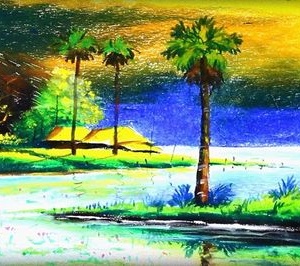Description
Olympia.
—————————————————-
Painting type:
Oil painting
Size:
20cm x 25cm
Note:
Unframed painting!
Info:
Olympia is a small town in Elis on the Peloponnese Peninsula in Greece, famous for its close-up archaeological site of the same name, the ancient Panhellenic religious site of ancient Greece, where the ancient Olympic Games were held. The site was very devoted to Zeus and attracted visitors from all over the Greek world as one of a group of “Panhellenic” institutions that helped to build ancient Greek as a nation. Apart from the name, there is nowhere near Mount Olympus in northern Greece, where the twelve Olympians, the chief deities of the ancient Greek religion, believe that they are inhabited.
The Olympic Games were held every four years throughout the ancient period, from the 8th century BC to the 4th century AD.
Olympia lies in the vast valley of the small Alfeiós River (also Romanized as Alpheus or Alpheios) in the western part of the Peloponnese, today about 18 miles [18 km] from the Ionia Sea but, perhaps, in ancient times, part of that distance. Altis, as the sanctuary was originally known, was an unusual quadrangular site more than 200 yards (183 meters) on each side and fenced off outside North where it was bounded by Kronion (Mount Kronos). It contained a series of architectural structures, most notably the Temple of Hera (or Heraion / Heraeum), the Temple of Zeus, the Pelopion, and the site of the great altar of Zeus, where great sacrifices were made. There was still a beautiful open space or wood inside the sanctuary. The name Altis was derived from the corruption of Elean’s name which also means “tree” because the area had trees, olive trees and planes in particular.
According to Pausanias, there were more than 70 temples in all, as well as a treasurer, altars, statues, and other structures dedicated to many deities. In contrast to Delphi, where the same large collection of monuments were tightly packed inside the temenos border, Olympia wandered across the border wall, especially at the venues dedicated to the games.
To the north of the sanctuary can be found Prytaneion and Philippeion, as well as a list of treasures representing various cities. Metroon is to the south of this treasure, and Echo Stoa to the east. The latest hippodrome was found east of the Echo Stoa. To the south of the sanctuary are the South Stoa and bouleuterion, while the palaestra, the Pheidias workshop, the gymnnion and the Leonidaion lie to the west.
Olympia was also known for the great image of chryselephantine (ivory and gold wood frame) the image of Zeus which was a cult image in his temple, made by Pheidias, named after one of the Seven Wonders of the Ancient World by Antipater of Sidon. Not far from the Temple of Zeus in the statue, Pheidias’ studio was excavated in the 1950’s. Evidence found there, like the tools of carpenters, corroborates this view. Ancient ruins are located north of the Alpheios River and south of Mount Kronos (named after the Greek god Kronos). The Kladeos, the Alpheios archipelago, roam around the area.
The archaeological site has housed more than 70 important buildings, and many of these ruins survived, although the majestic Temple of Zeus survived like stone on the ground. The site is very attractive to tourists, and has two museums, one dedicated to the ancient and modern theater.





